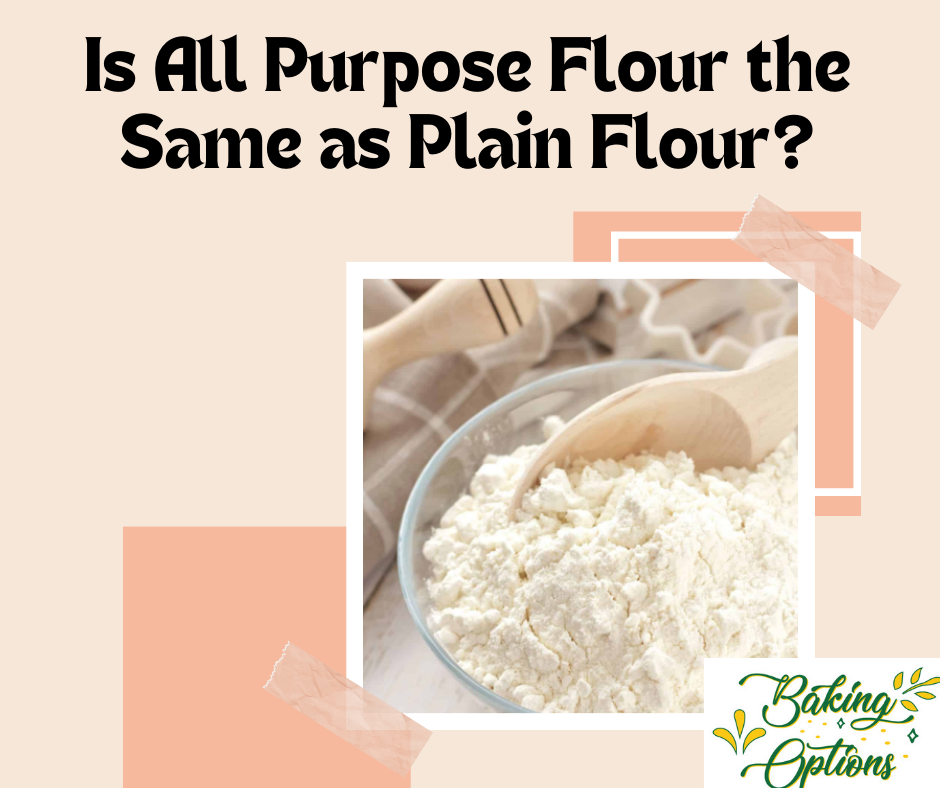Cooking is an art form, and much like choosing the incorrect paint color can destroy a picture, using the wrong ingredients may spoil even the best recipes. Instead, if you use the right tools, you can create a delicious dish.
You shouldn’t second-guess the significance of flour and yeast in a baking recipe—even beginners can understand it!
Because some recipes call for both types of flour interchangeably, it makes sense that perplexed beginners would begin to wonder how all-purpose flour is different from plain flour.
To see how things work out, keep reading!
Contents
- 1 Is Plain Flour The Same As All Purpose Flour?
- 2 Common Types of Flour
- 3 FAQs
- 3.1 What are the main uses of all-purpose/plain flour?
- 3.2 Can I use all-purpose/plain flour for making bread?
- 3.3 Can I substitute self-raising flour for all-purpose/plain flour?
- 3.4 How should I store all-purpose/plain flour?
- 3.5 Can all-purpose/plain flour be used for gluten-free baking?
- 3.6 Is there a difference between all-purpose/plain flour in different countries?
Is Plain Flour The Same As All Purpose Flour?

Yes. In Australia and the UK, all-purpose flour, which is widely used in America, is referred to as plain flour. Its bland, dry, and powdery flavor accounts for its simplicity—no additional flavorings or additives are present.
Furthermore, a lot of materials have several names that come from several nations or locations. Flour is one of those ingredients that goes by many names. Its name varies from those of other countries, just like in the UK.
What is All-Purpose Flour?
Made from wheat grains, all-purpose flour has a medium protein content. The dried wheat grains are ground and sieved extremely thoroughly until only a white, powdery material is left behind, free of any larger particles.
Since it’s not always possible to buy different types of flour, the industry created a flour that works well for practically all baking purposes. This flour is referred to as “all-purpose flour,” or simply “AP flour.”
How to Use All-Purpose Flours
It is best to use all-purpose flours in combination with other leavening agents. To make cakes, brown bread, and other sweets, all of these mixes are subsequently cooked or baked in ovens or griddles.
In order to avoid turning my delicious chicken and pumpkin soup into a thick pudding-like paste, I always thicken it with plain flour instead of cornstarch. These flours can also be used to make a roux, which is a thickening agent for stews and soups that are made with fat content.
Common Types of Flour

While all-purpose and plain flour are equivalent, what about the other varieties of flour? A wide range of flours are available in the market.
I have thus described different types of flour that are used to prepare different dishes in order to make it easier for your understanding.
Self-Rising Flours
The only differences between self rising and all-purpose flour are the additional salt and baking soda leavening ingredient that are added to self-rising flours after milling. Self-rising flours, which have a protein level of 7 to 9%, give good, high rises for quick bread baking and fast food preparation.
Sadly, it appears unrealistic to use them for yeasted bread or as a replacement for other forms of flour. However, for high-rise baked items like muffins, quick bread, pancakes, and scones, self-raising flour is still fantastic.
Pastry Flour
Excellent flour for use in pastries and other baked goods is pastry flour. It is very obvious from the name that it is intended for use in pastries like pies, cookies, and other light-baked goods.
Its protein content is in the middle of that of cake flour and regular flour. Its 8–10% protein content makes it perfect for dishes that call for a low protein and light texture.
However, although it is commonly confused with cake flour, it is actually distinct from cake flour due to its higher protein content. It can also harm your finished product if you use it in place of cake flour or cake flour in place of it.
Whole Wheat Flour
The entire kernel is used in the milling process to create whole wheat flour, which is the main distinction between whole wheat and all-purpose flour. The flour that is produced will be coarser and have a brownish or yellowish texture. Whole red wheat berries are used to make whole wheat flour, which is also referred to as wholemeal flour in the UK. It tastes a little more nutty.
When it comes to protein content, whole wheat flour varies depending on the brand and is quite high in fiber when compared to other wheat flours. Whole wheat flour is great for making chewy baked goods like bread.
00 Flour
A basic ingredient in Italian cookery, type 00 is used to make pasta and pizzas. Depending on the brand, it has a protein content ranging from 11.5 to 12.5 percent and is prepared from extremely hard wheat.
00 flour is an extremely fine flour that has been ground to the smoothest consistency imaginable. It therefore lends itself to doughs that leaven fast but naturally, particularly for preparing fresh pasta and pizza dough.
Bakers or Bread Flours
Have you ever wondered why bread flours work so well in baked goods? Their not-so-secret secret. This flour, which is made out of ground heart wheat, has an impressive 13–15% protein level.
Even better, their high gluten content guarantees the greatest chewy, well-structured crumb, which is the perfect combination for any type of yeasted bread.
I adore using them for baking because they provide chewy, well-formed crumbs that are full of air bubbles and lift throughout. My family has been really enjoying baked flour lately.
Cake Flour
Cake flour contains one of the lowest protein contents. And for that reason, it’s ideal for creating light goods like cakes. Cake flour and pastry flour are not the same, despite the fact that both are used to make goods with a lower protein content.
It has only 7–9% of the protein found in pastry flour, as opposed to 8–10%. The cake flour that is sold in stores is created from precisely milled soft wheat.
The icing on the cake is that cake flour is likewise produced by bleaching it until its pH approaches an acidic level. It enables the flour to improve cake rise and provide cakes with a better structure to prevent falling.
Coconut flour
The coconut meat, which has been dried and pressed to remove oil, is ground to make coconut flour. Shakes and smoothies are made using it. Because of its high protein level, this flour is difficult to work with but is very soft and delicate. And making it perfect for gluten-free baking.
The amount of this flour matters if you wish to replace all-purpose flour with it. You can use just ¼ cup of coconut flour instead of one cup of all-purpose flour because of its high absorbency. However, coconut flour can simply be used in place of ground almonds or oat bran in several gluten-free recipes.
FAQs
What are the main uses of all-purpose/plain flour?
All-purpose/plain flour is used for baking cakes, cookies, bread, and pastries. It is also used as a thickening agent for sauces and gravies and for breading meats and vegetables.
Can I use all-purpose/plain flour for making bread?
Yes, you can use all-purpose/plain flour for making bread, but bread flour is often preferred due to its higher protein content, which gives bread a better structure and chewiness.
Can I substitute self-raising flour for all-purpose/plain flour?
Yes, you can substitute self-raising flour for all-purpose/plain flour by adjusting the leavening agents in your recipe. For each cup of self-raising flour, reduce the baking powder and salt that the recipe calls for.
How should I store all-purpose/plain flour?
Store all-purpose/plain flour in an airtight container in a cool, dry place. This will help to keep it fresh and prevent it from absorbing moisture and odors from other foods.
Can all-purpose/plain flour be used for gluten-free baking?
No, all-purpose/plain flour contains gluten and is not suitable for gluten-free baking. For gluten-free baking, you should use specially formulated gluten-free flours or flour blends.
Is there a difference between all-purpose/plain flour in different countries?
The basic composition of all-purpose/plain flour is the same worldwide. But the protein content and milling processes can vary slightly depending on the country and brand.
My guide has studied various common flour types as well as the mystery surrounding all-purpose flour.

